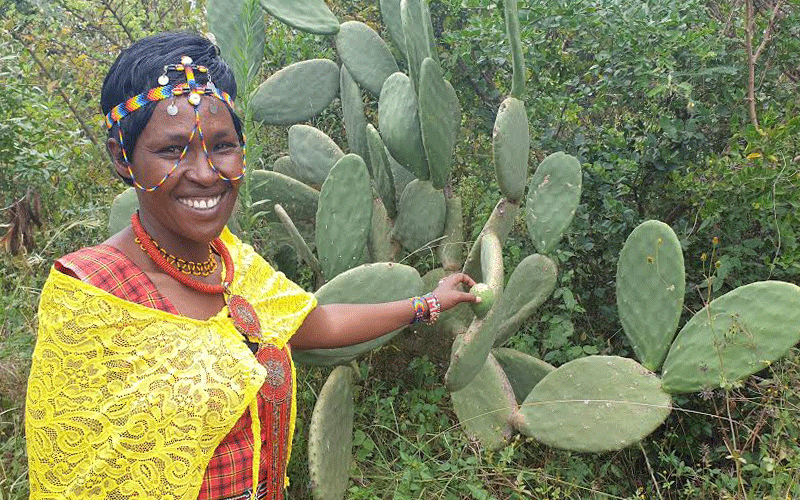Dreaded invasive plant now a blessing for Laikipia farmers

While growing up back in his Eleri rural village of Lakikipia county, Joseph Lentunyoi was saddened by the struggle people in his village went through attempting to tame the spread of a dreaded plant taking up precious space of land meant for livestock keeping. He remembers swearing to find a solution to the problem.
“I figured if not checked, the invasive cactus plant would take over the piece of land my parents and local animal keepers depended on for their livelihood,” he says.
That troubling feeling saw him proceed to Australia, years later after completing his secondary school education, for further studies to attempt to establish alternative economic benefits the cactus plant could be hiding.
“I carried out research on how the fortunes of livestock keepers in Laikipia county could be enhanced by turning the dreaded cactus plant into an income generating plant,” says the founder and director of Laikipia Permaculture Centre.
He has not only managed to advise locals on how best to tame the spread of the invasive plant, but also enabled them to smile all the way to the bank after adding value to the once dreaded plant.
Pastoralists in the expansive semi-arid county are now earning cash by making juice and wine from the plant and selling to local supermarkets and beyond.
Lentunyoi has mobilised locals into groups to ensure maximum benefits are reaped by the communities.
Women empowerment
Eleri Upendo Women group is one such grassroot organisation reaping the benefits of the one time dreaded plant.
“Labour expense is at a bare minimum because taking care of the plants does not need huge manpower as they grow naturally,” says Grace Kaparo, the chairlady of group, which sells the cactus fruits.
Eleri Upendo is among 11 groups, whose membership is mainly women, who deliver cactus fruits to LaikipiaPermaculture Centre.
“We have also been trained on establishing kitchen gardens as a way of diversifying food for our families” says Grace.
The cactus bears a sweet purple fruit, but its spines are dangerous for livestock as their prick blind the animals or damages their tongues and digestive systems, making it difficult for them to feed. It is also invasive, consuming land that would have been used for agricultural purposes.
The plants were also problematic to their children, who would often suffer injuries due to pricking.
Scientifically known as cactus opuntia, the plant was introduced into the country as an ‘innocent’ pot flower, but ended up spreading and taking over productive pasture land.
However, things have taken a new, better turn. The same plant, which has been a headache to residents is now a means of economic empowerment for the community.
After training in Permaculture in Australia Lentunyoi became a renowned trainer along this agricultural sector, and has often been sought internationally to offer trainings.
Wine and juice making
The process of making cactus juice and wine starts with community members picking ripe fruits of the plant from the fields.
After removing the thorny outer part, the members deliver fruits to Laikipia Permaculture Centre, for Sh500 per crate.
They are inspected for quality, with those with defects, such as spots or overripe being disposed off. After sorting, the fruits are cleaned with running water.
Fruit pulp is then extracted using an electric juicer, leaving out seeds.
For wine, the pulp is pasteurised to 70 degrees centigrade. It is then left to cool to 60 degrees centigrade and then left to ferment in airtight containers.
The same process is followed for juice, only that the process ends at cooling the pulp to 60 degrees centigrade.
To make bread jam, the pulp is pasteurised to 105 degrees and left to cool to 60 degrees centigrade.
This produces a concentrated version of juice, which is diluted at the ratio of one portion for twice the amount of water.
At every level of handling, Lentunyoi notes, high levels of hygiene must be observed to ensure the products are safe for human consumption.
“We ensure regular washing of hands as well as sterilisation of all equipment,” he explains.
A litre of wine retails at Sh1, 000 while that of juice goes for Sh500.
Cactus seeds are pressed to produce cosmetic oil and other beauty products, such as soaps, lotion and shampoo, but it is yet to be commercialised.
“Pressing the fruits means they are destroyed and cannot regrow, this being a way to control the growth of cactus plants,” explains Lentunyoi.
Laikipia Permaculture Centre is among the 57 grassroots organisations, which are members of the Participatory Ecological Land Use Management (PELUM) Kenya.
“We have been partnering with Laikipia Permaculture Centre by participating in their activities as they are friendly to the environment,” notes Benson Isohe, PELUM’s Regional Coordinator for Upper Eastern and Northern Kenya.
One such activity, Isohe adds, is by providing indigenous trees to communities, so that they can replace them with the invasive cactus.
So what after cactus is eliminated?
“We are slowly introducing forestry and bringing other economically viable plants, such as mulberry, moringa and strawberries,” says Lentunyai.
These plants, he adds, will ensure continuous production of the same products, which have been coming from cactus, once the invasive plant becomes history.









